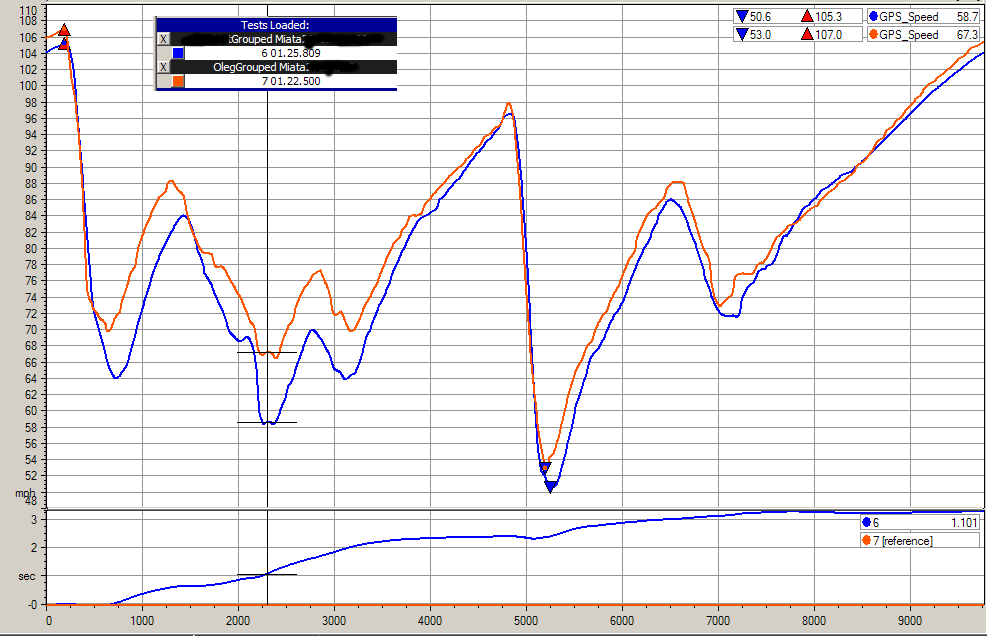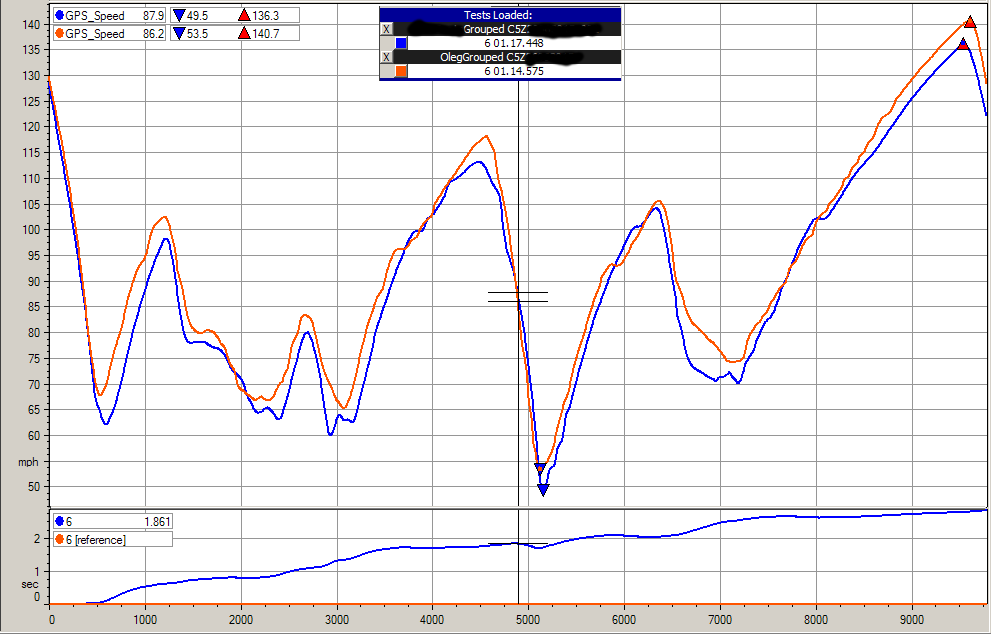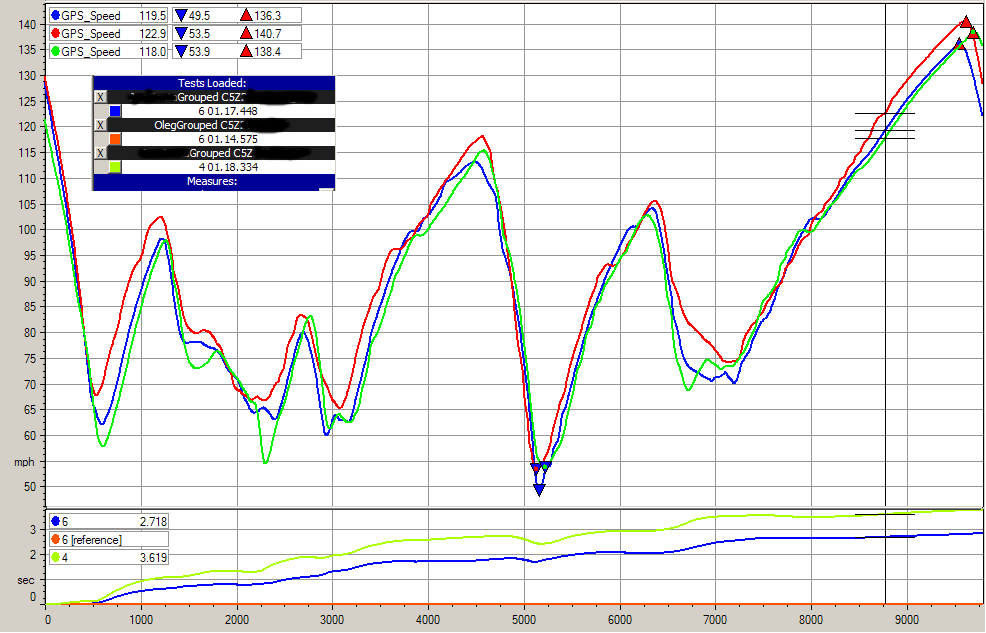8.5/10ths Vs 9/10ths Driving On Data
Published: July 8, 2015
Today we are going to look at the difference between 8.5/10ths and 9/10ths driving, as usual, with the aid of data. 8.5/10ths is the level at which the driver applies effort to "go fast", or, said differently, the driver begins to "push" for a good overall lap time. At 8.5/10ths the driver is not sliding the car at all; there may be some slip angle in the tires but the tires stay planted the entire way around a lap. Generally, a car being driven at 8.5/10ths does not produce tire noise. At 9/10ths, the car is sliding in some corners and does produce tire noise - significant when on street tires, less loud but still present on R compound tires.
For this comparison I have data from a Miata and a Corvette driven by the owners of the respective cars and myself, for a total of three drivers. All data was collected at the same event under virtually identical conditions.
Miata
First, let's look at a Miata being driven at 8.5/10ths and 9/10ths:

The first thing to note here is that the 8.5/10ths, 1:25 lap is - from inside the car - subjectively quite impressive when compared even to an 8/10ths lap. At 8.5/10ths, the driver is fast and things are happening quickly. An 8/10ths lap in the same car would be around 1:27-1:28 lap time. Unfortunately I do not have a clean 8/10ths lap on data.
From 8.5/10ths to 9/10ths though there is a remarkable difference in turn 1 and turns 2-3-4 complex. Turn 1 at 9/10ths employs trailbraking - evidenced by the 45 degree slope of the speed trace at the end of the braking zone - which permits much faster entry and earlier power application at the same time, yielding a 6 mph difference in minimum corner speed and a 0.5 second gain in lap time.
Turns 2 and 3 - which can be thought of as a single decreasing radius turn - are taken at a much higher speed. As each bar is 2 mph, there is up to a 6 mph speed difference again in this section. At 9/10ths, the rear end is slipping moderately through most of turn 3, requiring small steering corrections to stay on line. 9/10ths lap picks up another half a second here.
Turn 4 benefits from an aggressive curb cut - that extra foot of track width permits even more speed to be carried through turn 4. The 8.5/10ths lap also uses the apex curb but not to as much of an extent. The difference is in minimum corner speed in turn 4 is 8 mph, and it is carried on the straight between turns 4 and 5. Higher speed in turn 4 is worth just under a second for the 9/10ths lap.
Turn 5 at 9/10ths gets a more aggressive entry as well with the car just exceeding the grip limit as it is going over the hill and down the other side. This particular Miata exhibited understeer through turn 5 which permitted a high speed entry - if the entry was too fast, the car could simply be pointed into the apex further and it would understeer back on its ideal trajectory. Higher speed in turn 5 combined with the higher exit speed is worth about half a second of lap time.
The difference in turn 7 is less dramatic. Turn 7 is generally a corner that should be taken conservatively due to the length of the straight that follows it, and this strategy was employed in the 9/10ths run. However, the 9/10ths run committed to throttle earlier which again yielded a difference of up to 6 mph in corner exit speed. Higher speed in turn 7 plus higher exit speed are worth just under half a second of lap time.
9/10ths lap maintains full throttle deeper into the lightbulb followed by harder braking and earlier throttle application. Unlike 8.5/10ths lap which maintains speed for a brief distance, 9/10ths lap - due to later braking - transitions from braking immediately to full throttle. This is worth just under half a second of lap time as well.
An important observation is that the gains between 8.5/10ths and 9/10ths laps are spread roughly evenly between time in corners and time on the straights, which is to say, more aggressive driving does not just involve taking the corners quicker but also coming out of corners with a higher speed. Exit speed is crucial when pushing the car as it is when not pushing the car, and properly sliding the car increases exit speed in many (but not all) corners.
Below is a lateral G comparison between 8.5/10ths and 9/10ths laps. The 9/10ths lap achieves higher peak lateral Gs and holds the car at peak Gs longer than the 8.5/10ths lap.

Corvette
Next we have data from a Corvette running at the same track. The Corvette had a different owner from the Miata.

The difference in turn 1 between the two laps for the Corvette is very similar to the respective difference in the Miata. The 9/10ths lap carries about 5 mph more through and out of the turn, and also has a significantly earlier power application point - just before the apex on the uphill rather than after the apex on the downhill. Combined this results in a half second gain.
Turn 2 appears to be quite close between the two laps in the Corvette. However, at any given track position the 9/10ths lap has up to 5 mph more speed than the 8.5/10ths lap, thus in this case data can be misread. The extra 5 mph means at 9/10ths the car is loose and "dancing" a little through the turns 2-3 complex, and the result is a quarter second gain in lap time.
In turn 4 several factors combine to make the 9/10ths lap much quicker. First is aggressive curb usage, which widens the track significantly and permits an extra 2-3 mph at the apex. Equally importantly, the extra track width allows for earlier throttle application coming out of turn 4. The result is nearly a half second gain by the braking zone for turn 5.
In turn 5 reference points, vision, confidence and aggression come together for a full second gain in lap time. Let's break this corner down.
First, the throttle application point is selected to permit non-decreasing throttle and full throttle application as soon as possible. The orange line has a steady upward slope; the blue line for the 8.5/10ths lap indicates that the driver began applying throttle earlier but had to immediately back out of it and then applied maintenance throttle through most of the turn.
Next, braking in turn 5 is arranged to bring the car to the appropriate speed at the throttle application point. There is a bit of trailbraking going on as the car enters the uphlil, and braking overall is gentler because the trajectory of the car curves - remember, the 9/10ths lap is braking until the hill or even part of the way up the hill, while the 8.5/10ths lap is braking in a striaght line between turns 4 and 5.
Finally, the braking point in the 9/10ths lap is later to maintain said gentle but firm braking pressure throughout the braking zone.
In turn 7 the 9/10ths lap brakes later which I attribute largely to confidence. This by itself provides minimal gain in lap time; however, the 9/10ths lap also does not decelerate the car to as low of a speed as the 8.5/10ths lap - and this, combined with earlier throttle application again, yields a half second gain over the straight between turn 7 and lightbulb.
Lightbulb is generally a vision and confidence corner in most cars, this particular Corvette being no exception. The 9/10ths lap, braking later and carrying up to 8 mph more through the braking zone, picks up another half a second over the 8.5/10ths lap.
Looking at the lateral G plot, 9/10ths lap has significantly higher lateral acceleration in turns 5 and the lightbulb, which is to be expected:

It is interesting also to look at 8/10ths driving in the context of the current discussion. Below plot has an 8/10ths lap added in green; this lap was driven by the owner of the car early in the weekend.

The 8/10ths lap has lower cornering speed and correspondingly exit speed in turn 1, stemming from less aggression. In turn 2 on the 8/10ths lap the driver braked much more for a very comfortable entry speed in turn 3, whereas on the 8.5/10ths and 9/10ths laps the drivers carried speed through turn 2 into turn 3. Turn 4 is similar - 8/10ths lap sees major braking whereas 8.5/10ths and 9/10ths lap carry speed through the turn. Approaching turn 5 on the 8/10ths lap the driver stopped accelerating earlier and was also braking less hard. In turn 7 on the 8/10ths lap the driver again decelerated to a comfortable pace rather than carrying speed through the turn. Lightbulb is remarkably similar between 8/10ths and 8.5/10ths laps, which to me suggests that the 8.5/10ths lap was relatively conservative in the lightbulb.
Tagged: data analysis
 Visit our
Visit our